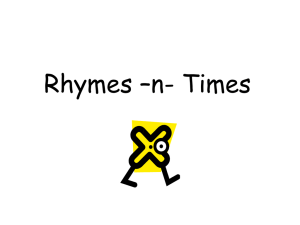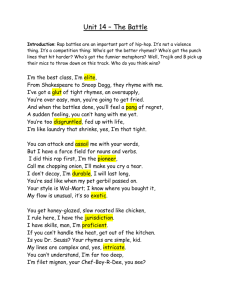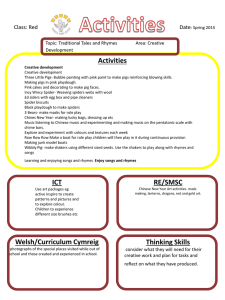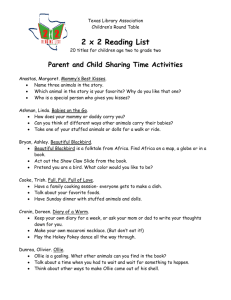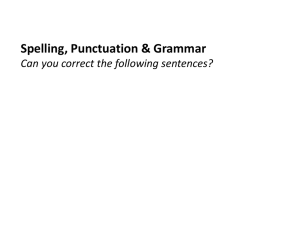Challenges & Strategies in Reading and Writing ASD
advertisement
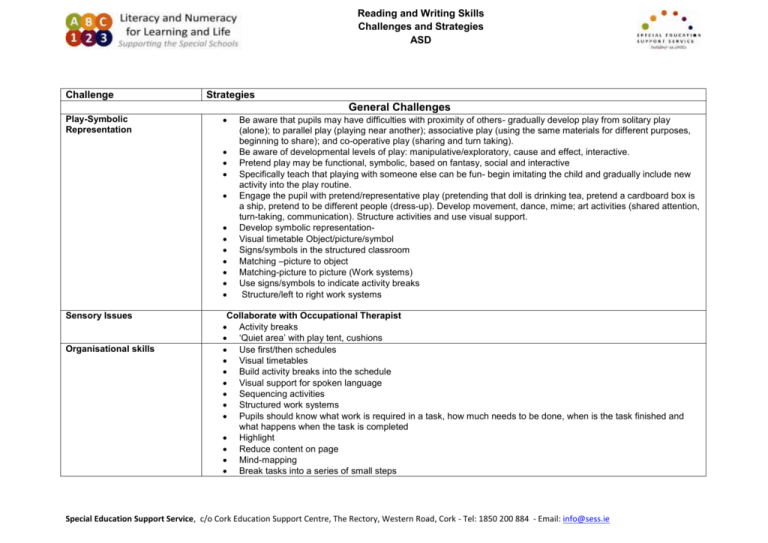
Reading and Writing Skills Challenges and Strategies ASD Challenge Strategies General Challenges Play-Symbolic Representation Sensory Issues Organisational skills Be aware that pupils may have difficulties with proximity of others- gradually develop play from solitary play (alone); to parallel play (playing near another); associative play (using the same materials for different purposes, beginning to share); and co-operative play (sharing and turn taking). Be aware of developmental levels of play: manipulative/exploratory, cause and effect, interactive. Pretend play may be functional, symbolic, based on fantasy, social and interactive Specifically teach that playing with someone else can be fun- begin imitating the child and gradually include new activity into the play routine. Engage the pupil with pretend/representative play (pretending that doll is drinking tea, pretend a cardboard box is a ship, pretend to be different people (dress-up). Develop movement, dance, mime; art activities (shared attention, turn-taking, communication). Structure activities and use visual support. Develop symbolic representationVisual timetable Object/picture/symbol Signs/symbols in the structured classroom Matching –picture to object Matching-picture to picture (Work systems) Use signs/symbols to indicate activity breaks Structure/left to right work systems Collaborate with Occupational Therapist Activity breaks ‘Quiet area’ with play tent, cushions Use first/then schedules Visual timetables Build activity breaks into the schedule Visual support for spoken language Sequencing activities Structured work systems Pupils should know what work is required in a task, how much needs to be done, when is the task finished and what happens when the task is completed Highlight Reduce content on page Mind-mapping Break tasks into a series of small steps Special Education Support Service, c/o Cork Education Support Centre, The Rectory, Western Road, Cork - Tel: 1850 200 884 - Email: info@sess.ie Organisational skills (cont) Motivation/Enjoyment Narrow range of interests Problems with shared attention/reciprocal communication Use a multi-sensory approach Keep instructions short – CHUNK Demonstrate instructions with diagram or picture Allow thinking time – revision picture / mind map Checklists / Adhesive notes Transparent pencil case Check the seating position of the student away from sources of noise (projectors/ open doors/ computers etc.) Graphic organisers Begin with high interest text/stories Use interactive, tactile books Use books which have a high level of factual content Reading buddy. books of high interest, repetitive books, songs, poems, rhymes Read ‘Silly sentences’ Stories About Me- begin with student interests Choice with visual support Reading corner with a wide range of books and reading material available Tactile/interactive books Story time at home Token economies ICT Listening centre with books and cassettes/CDs Google favourite stories to get audio versions Make a movie:-video the students dramatizing a favourite book and share with other classes. Use preferred interests to motivate Gradually introduce new material with teacher modelling Teacher/student take turns to work on new material Use ICT/APPS Play turn-taking games with visual/ written instructions Use the student’s interests to motivate and follow the student’s lead in activities Gradually increase the timeframe of shared activities Reading Vocabulary Phonological skills Fluency Stories, songs, rhymes, games, routine interactions Build up sight vocabulary based on interests, family, classmates Social sight words Word walls Picture to word matching Identify letters in words Identify words only PECS/visuals : vocabulary to sentence structure Use pictures to support meaning Develop vocabulary through play and social interactions Use a picture dictionary Generalise classroom vocabulary to different locations Multi-Sensory Approach Focus on Rhythm, Rhyme, Words, Syllables through songs, stories, poems, rhymes, clapping, tapping Clap out syllables; songs, raps and rhymes Begin with initial sounds- student’s name Extend to other words with same initial sound Focus on sounds of other letters Associate sounds with patterns in rhymes, with words, signs, symbols and letters Sounds and names of the alphabet • • • • • • Teacher reads aloud every day Use books with repetitive texts Peer/paired reading Talking books Focus on favourite book Record student reading well known text Comprehension • • • • • • • • • • • • • • • • • • Sequence photos from student’s daily routine First/Then Yes/No ‘Specific teaching of ‘Wh’ question words Pictures/visual support for why/because, cause/effect Predicting-begin with repetitive books Re-reading text to develop understanding Story retell with visual support Focus on factual books and literal comprehension to begin Specific teaching of the story title, setting, characters, problem, solution, main idea. Specific teaching of context Use diagrams, graphics, tables. Move from teacher supporting the student to independent work Check the readability of the text. Reduce the amount of text on each page Offer choice as to the number of questions answered Highlight difficult words. These words can be written on the board/flashcards and taught explicitly. Writing Fine motor skills/motivation Theraputty, clothes pegs, threading, cutting, pasting, tracing ,colouring Choice of writing implements Wide variety of implements-include with art activities Token economies/motivators Short achievable tasks Typing programmes Spelling High frequency words Visual approach Teach with whole word approach Trace letters Build up words with component parts Grammar Vocabulary Writing Genres Writing Process Use different colours for nouns, verbs and adjectives to build sentences PECS/ visuals Teach in context through play e.g. sand and water tray, dressing up, toy house, day to day interactions Teach with whole word approach to reading Picture to word, word to word match Word walls Lotto games Personal dictionary Recount: News, diaries Narrative: Stories, News, letters, cards, notes Report: Factual report, report on news item, report on area of interest, book report Explanation: How to make a sandwich, how I come to school, how to pack my bag (task analysis and checklists) Persuasive: Write an advertisement or flyer for school event Procedure: Directions, rules, recipes Writing for environmental signs Writing messages Use post-its to write one fact about self Write ‘Silly Sentences’ Writing instructions, recipes, shopping lists Wall charts with pictures and captions about class activities Create books about individual students with pictures and captions Draw a picture and write a sentence Develop a framework: Use mind-maps/flowcharts to focus on topic and specific vocabulary Include vocabulary for emotions Develop vocabulary into sentences Sequence sentences into story Teach use of first/next/then Punctuation: capital letters and full stops Edit, proofread, publish and display Scramble and unscramble story sentence strips ICT/APPS

